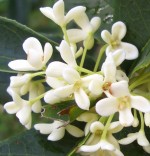 For fragrance, sweet olive ranks with jasmine, gardenias, and honeysuckle. A native of eastern Asia, it is a member of the olive family, Oleaceae, that also includes jasmine, lilac, and privet. A large evergreen shrub or small tree, it grows up to twenty to thirty feet tall and fifteen to twenty feet wide but is usually six to twelve feet high. When young it is upright and columnar but becomes vase shaped as it matures. The shiny medium-green leaves are finely toothed and are held at the ends of the stems. From fall to spring and sporadically during the summer, white to yellow or orange flowers are produced in small clusters. Although usually not very showy, they produce an very strong fruity fragrance that is variously described as apricot, peach, or citrus. This is an excellent plant to place as a specimen near a patio, walkway, window or other place where its fragrance can be enjoyed. Its columnar habit when young makes it a good plant for use in a hedge or screen and it can also be grown in a container and brought indoors in cold climates.
For fragrance, sweet olive ranks with jasmine, gardenias, and honeysuckle. A native of eastern Asia, it is a member of the olive family, Oleaceae, that also includes jasmine, lilac, and privet. A large evergreen shrub or small tree, it grows up to twenty to thirty feet tall and fifteen to twenty feet wide but is usually six to twelve feet high. When young it is upright and columnar but becomes vase shaped as it matures. The shiny medium-green leaves are finely toothed and are held at the ends of the stems. From fall to spring and sporadically during the summer, white to yellow or orange flowers are produced in small clusters. Although usually not very showy, they produce an very strong fruity fragrance that is variously described as apricot, peach, or citrus. This is an excellent plant to place as a specimen near a patio, walkway, window or other place where its fragrance can be enjoyed. Its columnar habit when young makes it a good plant for use in a hedge or screen and it can also be grown in a container and brought indoors in cold climates.
Type: Evergreen shrub or small tree
Outstanding Features: Fragrant flowers
Form: Upright, columnar when young; vase-shaped when mature
Growth Rate: Slow
 Bloom: Clusters of small white to yellow to orange flowers are borne from fall to spring and sometimes sporadically in summer
Bloom: Clusters of small white to yellow to orange flowers are borne from fall to spring and sometimes sporadically in summer
Size: 6-12′ H x 6-12′ W
Light: Morning sun and afternoon shade is ideal
Soil: Average, moist to average, well-drained
Hardiness: Zones 9-11
Care: Prune any time to control size and encourage branching; pinch ends to increase density.
Pests and Diseases: Susceptible to scale and nematodes
Propagation: Cuttings in late summer
Outstanding Selection: ‘Aurantiacus’ (orange flowers mostly in October).
